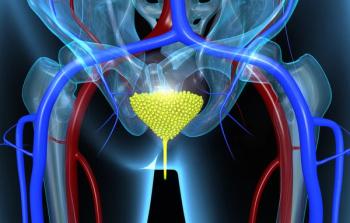
Epacadostat/Pembrolizumab Promising in Advanced Bladder Cancer in Early Trial
The combination of pembrolizumab and the IDO1 inhibitor epacadostat was active and generally well tolerated in patients with urothelial carcinoma.
The combination of pembrolizumab and the IDO1 inhibitor epacadostat was active and generally well tolerated in patients with urothelial carcinoma (UC), according to results of a phase I/II trial (
Pembrolizumab, a PD-1 inhibitor, has significant activity in UC and is now approved for several indications based on relatively high response rates and survival outcomes. “Despite these impressive results, only a minority of patients actually respond to this therapy,” said David C. Smith, MD, of the University of Michigan in Ann Arbor. “Thus, additional combination therapy is of interest.”
Smith presented results of a phase I/II trial of pembrolizumab along with epacadostat at the 2017 American Society of Clinical Oncology (ASCO) Annual Meeting in Chicago. The new agent is a potent, specific, oral inhibitor of the intracellular enzyme IDO1; inhibiting this enzyme inhibits tryptophan metabolism, augmenting immunosurveillance in the tumor microenvironment and potentially improving outcomes when combined with an immune checkpoint inhibitor.
The study included a dose escalation cohort and a safety expansion cohort in the phase I portion, followed by a phase II cohort that included multiple tumor types. This report included a total of 40 patients with advanced UC; all patients had progressed during or following treatment with platinum-based chemotherapy or alternative therapy in the adjuvant or advanced disease setting.
Of the 40 patients, two completed the course of treatment with epacadostat, 11 had ongoing treatment, and 27 discontinued due to disease progression (18 patients), adverse events (5 patients), patient decision (3 patients), or death (1 patient). They were followed for a median of 33.8 weeks.
The objective response rate (ORR) by RECIST criteria was 35%, with three complete responses (8%) and 11 partial responses (28%). Another seven patients had stable disease, yielding a disease control rate of 53%; five patients were not evaluable. Most of the responders had received fewer than two previous lines of therapy, and when stratified as either PD-L1–positive or negative, those expressing PD-L1 had a higher ORR (64% vs 13%). By immune-related RECIST, the ORR was 38%, and the disease control rate was 60%.
Most of the responses (10 of 14) were ongoing, and the median duration of response was 30.6 weeks. The two patients who completed the study treatment have maintained their response.
Twenty-eight patients (70%) experienced an adverse event (AE) of any grade, and nine patients (23%) had a grade 3/4 AE. Two patients required a dose reduction due to an AE (rash), and three discontinued the therapy due to toxicity (exacerbation of chronic obstructive pulmonary disease, colitis, and rash). There were no treatment-related deaths, and Smith said the AEs were manageable with supportive care.
“The efficacy of this combination in patients with UC with less than two lines of therapy supports the development of a phase III trial,” Smith concluded.
Jonathan E. Rosenberg, MD, of the Memorial Sloan Kettering Cancer Center in New York, was the discussant for the session, and he noted that this was a relatively lightly pretreated cohort compared to some other trials. However, he said the ORR is promising. “Certainly this is worth of further evaluation,” said Rosenberg.
Newsletter
Stay up to date on recent advances in the multidisciplinary approach to cancer.






















































































